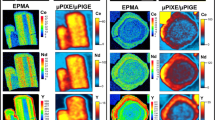Abstract.
Oscillatory zoning in plagioclase is investigated at small scale (≤10 µm) using accumulated backscattered electron (BSE) images as high-resolution imaging method. Combined with electron microprobe quantitative analysis, gray-value profiles across these images can be calibrated for An-content with a resolution of 0.5 mol% An. Applied to oscillatory-zoned crystals, this new application of BSE imaging allows better characterization of zoning patterns along a profile and quantification of wavelength, amplitude, and shape of the oscillations. We also obtain high-resolution information on the morphology of growth zones boundaries. This approach allows us to better classify the different types of "oscillations" and concentric zoning. Dissolution is more frequent than usually recognized. Major resorption surfaces crosscut several growth zones. Irregular 5–10-µm saw-tooth zones are delimited by faint wavy dissolution surfaces and must be distinguished from small-scale oscillations (≤1–3 µm) with straight boundaries. This suggests at least two mechanisms for the formation of these zoning patterns: faint oscillations are probably caused by local kinetic control whereas wavy dissolution surfaces involve magma chamber dynamics.
Similar content being viewed by others
Author information
Authors and Affiliations
Additional information
Electronic Publication
Rights and permissions
About this article
Cite this article
Ginibre, C., Kronz, A. & Wörner, G. High-resolution quantitative imaging of plagioclase composition using accumulated backscattered electron images: new constraints on oscillatory zoning. Contrib Mineral Petrol 142, 436–448 (2002). https://doi.org/10.1007/s004100100298
Received:
Accepted:
Issue Date:
DOI: https://doi.org/10.1007/s004100100298




